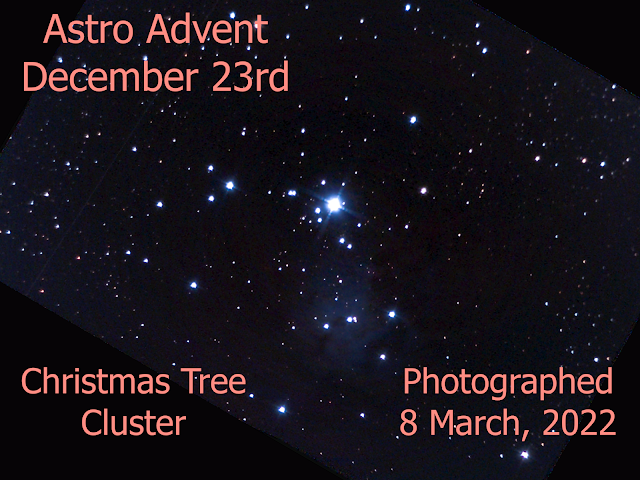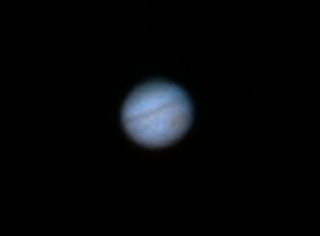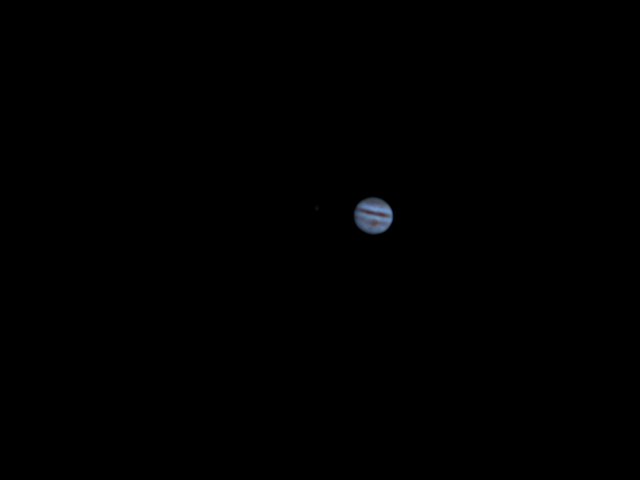UPDATE: This blog post is now out of date, to see the newest information have a look at my Here Comes the Sun post.
This is a good time to observe our nearest star, the Sun. The last several years the Sun hasn't had many sunspots, but there have been plenty of them recently, making the view more interesting.
Observing the Sun with a telescope should only be done with the use of a solar filter that fits over the front end of the telescope.
I use a solar filter from Thousand Oaks Optical (SolarLite 5.75-inch) for my Unistellar eVscope 2. The Sun fits nicely within its field of view. Alas, the field of view is a bit too small for the whole Sun to be seen in an eVscope 1 or eQuinox.
Pointing the telescope at the Sun isn't too difficult. The key is to look at the telescope's shadow.
When the shadow is smallest the telescope is pointed at the Sun.
Focusing isn't easy. You can't use the Bahtinov mask. Instead, look very closely at some sunspots or even the edge of the Sun and carefully adjust your focus. It is usually best to take several images with slightly different adjustments and pick your best one.
Most solar filters impart some color to the view of the Sun which is white in color (yes, many people refer to the Sun as a yellow star, but trust me, it's white). The combination of the Thousand Oaks filter with the fact that the eVscope is sensitive to near infrared light gives the Sun a color that isn't too pleasing to me (or very Sun-like):
This is easily fixed by simply converting the image to grayscale. I also usually do some very simple post-processing (on my phone!) to improve the sharpness and contrast of the image.
When an eVscope is used to observe the Sun, it will not track on it, so you'll need to periodically move it to keep the Sun centered in view. This is very easy to do in version 2.0 of the Unistellar app.
Other than watching sunspots come and go, what can you do by observing them? I recently photographed the Sun seven days in a row to produce this short animation showing the Sun's rotation:
I cropped, aligned and rotated my images in Photoshop so that I could create this sequence.
The Sun takes about 27 days to make a full rotation, but it isn't a solid body, which means that its rotation period is different at its equator than it is at its poles. As the Sun spins this differential rotation helps to twist and warp its magnetic fields. When these magnetic fields break the Sun's surface (called the photosphere) they partially block the flow of heat from the Sun's interior giving rise to sunspots.
The immensity of the Sun is beyond the human experience. To give you a sense of perspective, let's look at one frame from the sequence above:
Do you see the blue dot that I added? That's the size of Earth compared to the Sun. Yes, the Sun is huge. 109 Earths could fit across its diameter.
The Sun is the source of the energy that powers life on Earth. As Earth orbits around the Sun we get different amounts of sunlight due to the fact that Earth's axis is tilted. When, as we are now, the Northern Hemisphere is tilted toward the Sun we get more daylight and that daylight is more intense. This gives us summer. At the same time those in the Southern Hemisphere are experiencing winter. It is this tilt that creates our seasons.
Most people mistakenly assume that the seasons are caused by Earth's distance from the Sun. Earth's orbit is ever so slightly elliptical, meaning that our distance from the Sun does indeed change, but it isn't a big change. Surprising to most people is that fact that we are closest to the Sun in January during winter in the Northern Hemisphere. This does mean that the apparent size of the Sun in our sky changes from early January when we are closest to the Sun to early July when we are farthest from it.
You would never notice this distance with your eyes (you shouldn't look directly at the Sun anyway), but it is clearly visible with a telescope:
I am sure that I'll come up with some other solar observing projects in the future, but that's it for now.

















































